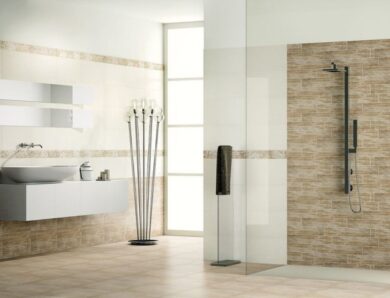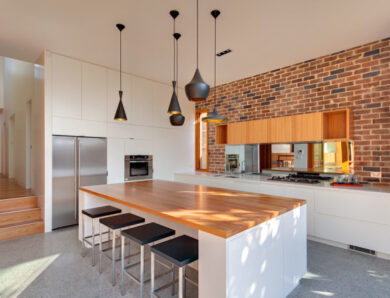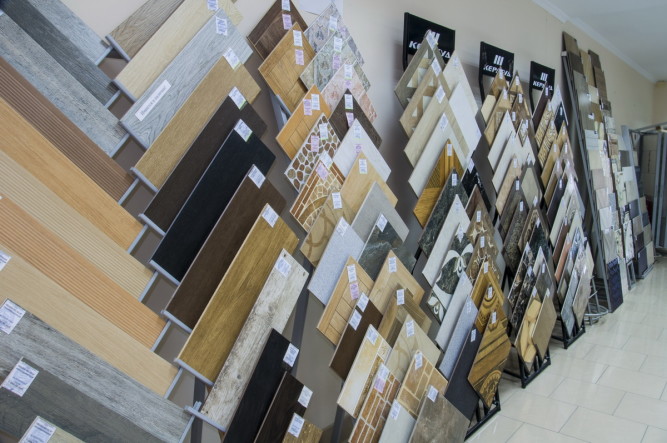Laying tiles in the bathroom: options and methods
Tile layout directly affects the visual perception and style of the interior of the bathroom. There are many ways to decorate this room. Consider the most popular options.
Tile design creates interior style
Floor finishing
The choice of method of laying ceramic tiles in the bathroom depends on the material, used to decorate the room. It is important to choose the right size and shape of the tile, as well as color and style. The design of the room depends on it.
The best solution is a medium tile format, it looks great in large areas and does not steal space in a small bathroom. Rectangular tiles are becoming popular, this applies as a floor, and wall ceramics. The mosaic looks equally interesting in the interior. Often combine several models of tiles.
It is convenient to use computer programs for interior modeling to work out different variants of tile layout.
Let's highlight the following approaches in the design of the floor:
- Seam to seam. This is the standard way, used with square tiles. The joints must match in each subsequent row.
- Scattered. This option is more suitable for rectangular elements. With their help the laminated or parquet covering is simulated. Also due to the elongated shape of the tile visually enlarges the corresponding side of the room. The method is to shift each subsequent row on the floor-element.
- Diagonal. This tile layout is recommended for use in a small bathroom. Suitable for products of any format and visually expands the space.
Three options for laying floor tiles
Try to use the tile this way, so that there are fewer threaded elements in the visible areas. If there is enough space and acceptable layout of the room, you can lay out on the floor a composition of different colors and parameters of the elements, creating a pattern or drawing.
Options for unusual tile layout
Ways of wall layout
More design solutions are available here, because the area is larger. Let's select the following options for the layout of the tiles on the walls of the bathroom:
- Monophonic surface. Seam to seam is performed, run up. The same tile is used over the entire plane of the wall.
- Diagonal. Rarely used, but, allows you to achieve an interesting effect. Visually pushes the space, which is relevant in small spaces.
- Dividing the curb. This is a standard option, when two similar shades are combined on the surface of the wall, separated by a narrow border. Most often, the dark color is placed at the bottom.
- Decorative stripes. Friezes are used here, tile of contrasting shades and other forms. Horizontal drawing increases the visual perception of the room in width, and vertical - in height. Combine both receptions, also make inserts in separate zones exclusively for the decorative purpose. With the help of stripes create a pattern or a simple geometric pattern.
- About the insert. These are individual tiles, often from the same series, as the main tile, on the surface of which there is a drawing with three-dimensional details, glazed. Two or three inserts will allow you to unobtrusively diversify the design of the surface and focus on a particular area.
- Complex compositions. At such apportionment of a ceramic tile several types of material are combined among themselves, and on the wall of the bathroom is laid out an insert in the form of a picture. It is still framed with a mosaic or frieze.
Design options
Facing of additional surfaces
In addition to walls and floors, often have to process tiles and other planes, example, curbs, partitions, screen baths. Options for laying tiles in this case are little different from the above. When choosing a specific method, pay attention to the idea and follow the given topic.
For processing of small details it is more convenient to use a small-sized tile or a mosaic. This material will facilitate the installation process and create additional decorative elements and inserts.
At facing of borders and partitions apply the simple scheme "seam in seam". The exception is the situation, when a different principle is used in the interior and such a design will stand out.
The layout of the bathroom screen is also selected in accordance with the overall design. However, you can emphasize this area and orient the tile in the opposite way, example, diagonally. Additionally, this area is distinguished by selecting a contrasting color tile.
Examples of facing
Using mosaic
This material is small in size, but still combines well with larger elements. Here are the following ways to use mosaic tiles in the bathroom:
- Facing of walls. Monotone, with the effect of flicker or pattern - the design depends solely on the personal preferences of the owners of the house.
- Floor finishing. Creates a complex ornament even in the conditions of small open space.
- Delimitation of functional zones. More often a mosaic allocate area of a shower and a wall over a bathroom.
- Arrangement of accents. Pays attention to a specific area, example, a place to hang towels or space above the sink.
- Local decor. Mosaic is used to decorate a small bathroom area, creating stripes or ornaments.
- Facing of difficult places. We are talking about small and complex in shape elements.
Options for using small-format tiles
Despite the fact that the mosaic is sold as a set of small details, fastened with mesh or paper, single fragments are also used, example, for arrangement of a frame or a local decor.
Each way of laying tiles can favorably emphasize the originality of the bathroom. A specific option is chosen based on the characteristics of the room, taking into account personal tastes and preferences.



